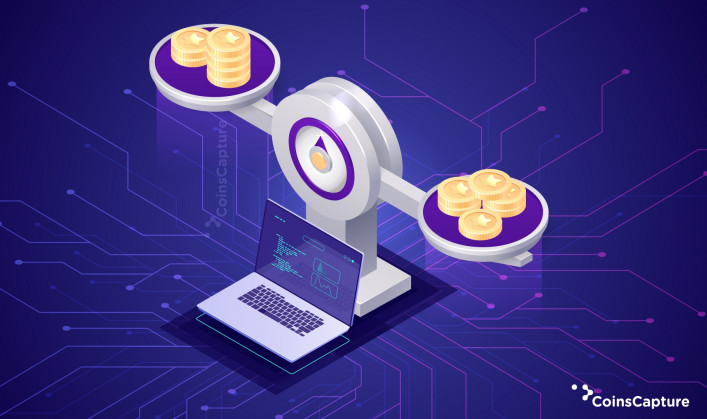7 November 2025
Algorithmic Stablecoins How Is It Different?
Due to the obvious unpredictable characteristics of Cryptocurrencies, stablecoins had been created. To guarantee market consistency, those coins are frequently tied to fiat money, like the US Dollar. Stablecoins come in a variety, each of which uses a different method to keep its value tied to the currency it monitors. Algorithmic stablecoins have gotten a lot of attention recently. Modern decentralized finance (DeFi) is characterized by an abundance of exploration and invention, as well as a focus on performance.
Also Read: Why 5 Best Cryptocurrencies Failed?
Turbulence in Cryptocurrencies is well-known; they may rise and fall through double digit figures. Those who wish to avoid the industry instability but remain invested in Cryptocurrencies might turn to stablecoins, an alternative version of the digital money. For the most part, stablecoins, just like dollars, are designed to be backed by the US currency. Stablecoins that are tied to the US dollar are expected to remain at $1 at all times. The method each stablecoin project maintains the peg varies. "Over-collateralized" by fiat reserves, Tether and Circle's USD coin (USDC) contain currency or capital commodities in their savings. Because of this, the value of each USDT or USDC on the Cryptocurrency space is supported by what stablecoin holders truly own.
Also Read: 5 Best Cryptos To Mine In 2022
Types of Algorithmic Stablecoins and How they Work?
Algorithmic stablecoins may be divided into two categories: rebase and seigniorage stablecoins. In order to preserve a stablecoin's linkage to fiat money, rebase stablecoins alter supply. To keep the stablecoin's value stable, the protocol adds or destroys coins in accordance with the market fluctuation. Stablecoins are withdrawn from circulation if their value falls under $1, and likewise. In the same way that seigniorage stablecoins function, for more control over its value, customers may also combine the stablecoin with some other Cryptocurrencies. There is a system in place to encourage market players to purchase and sell the associated Cryptocurrencies in order to keep the stablecoin's cost constant.
How is UST Designed to Maintain its Peg?
Through an algorithmic link with Terra's native coin, LUNA, TerraUSD (UST) maintains or is meant to maintain its 1:1 parity with the US dollar (USD). Every time UST loses its peg, there is an offset chance that can be exploited. The rate of UST rises over $1 when the UST supply is insufficient and demand is strong. Individuals may exchange 1 USD of LUNA for 1 UST on the Terra station website as part of the Terra protocol's effort to restore UST's peg. One LUNA is used to make one UST, which may be sold for 1.01 USD to make a gain of one cent. It doesn't seem like much, although when done in huge numbers, those earnings may really mount up.
The Future of Algorithmic Stablecoins
There has been a lot of usage of algorithmic stablecoins in volatility markets and asymmetrical trading till today. With the latest Terra collapse, the future is gloomy. Stablecoins might also face harsh rules from the government, which is maintaining a close watch on the business. In reality, Janet Yellen, the US Treasury secretary, addressed the Terra case in a session on stablecoin legislation earlier this year. Yellen said that UST is a developing market and there are quickly increasing hazards throughout her testimony. Stablecoin legislation must be passed before the end of the year, if not sooner.
How Did UST Depeg in May 2022?
As Terra's major DeFi protocol Anchor started to remove substantial volumes, UST started depegging on May 7. DeFi's major stablecoin volatility base, UST, using Ethereum's Curve Protocol, witnessed huge volume withdrawals as a result of these events. In the wake of UST's depegging, some claim that a concerted assault was to criticize. While some believe it was owing to the worsening market circumstances, others believe it was because of LFG's decision to increase its reserves in order to support UST. As a result, the stablecoin's peg finally dropped to as little as $0.29 on May 11 despite the pressures.
The Bottomline
In the wake of the launch of algorithmic stablecoins, decentralization has never been more promising. Algorithm-based stablecoins provide a solid basis for a fully scalable solution when compared to other options. Non-decentralized stablecoins are less prone to personal mistakes since they do not need the support of physical assets. Stablecoins built on algorithmic programming have the potential to establish confidence since the coding is open and auditable. Discovering the actual capability of algorithmic stablecoins may be aided by having a firm grasp on the many kinds, successful measures, and dangers that are involved.
Disclaimer: The author’s thoughts and comments are solely for educational reasons and informative purposes only. They do not represent financial, investment, or other advice.






